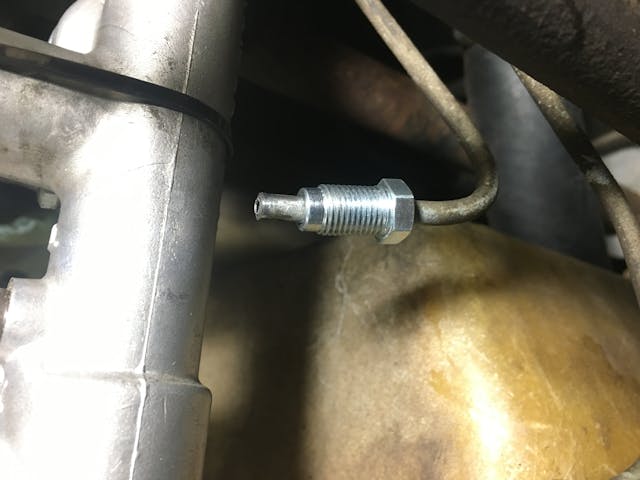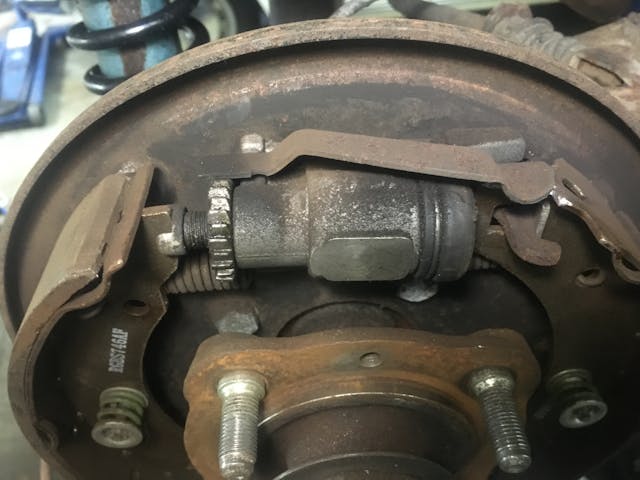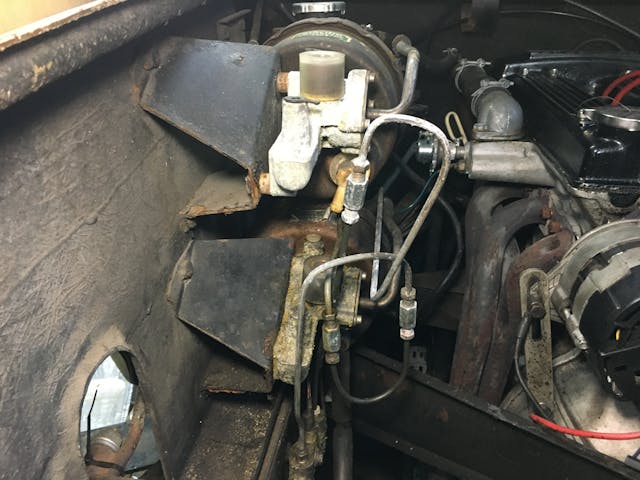Media | Articles
The Great Lotus Europa / Datsun F10 Master Cylinder Swap (Part 3: The Bleeding From Hell)

Last week, I admitted to you something that most folks would share only with their therapist—that seeing the adjective “straightforward” applied to retrofitting a Datsun F10 master cylinder into a Lotus Europa triggers me into a Three Stooges’ NIAGRA FALLS! (“Slowly I turned …”) level of rage.
But I got it done, only to find that the symptom that caused me to replace the master cylinder in the first place—a brake pedal that was soft and with travel that was obviously too long and that pumped up firm with a single pump but repeated the whole thing just 10 seconds later—was unchanged. In other words, I hadn’t fixed it. Grrrrrr.
So I’ll admit something else—I’m magnifying my level of annoyance because, well, because it’s funny. Really, the swap went about as expected. The issue of the troublesome unadaptable 7/16-20 fitting on one of the brake lines was just a detail, albeit a vexing one. In a perfect world, we’d all be alerted to these sorts of stumbling blocks up front. When I write my version of the swap in detail for one of the Lotus Europa forms, I’ll do exactly that; I’ll say, “Understand that you have no choice but to cut the flare off the line with the 7/16-20 fitting, substitute a more conventional fitting, and re-flare the line, because there is no commercially-available adapter.” The world doesn’t always spoon-feed us the information that we think is the crux of a project. We usually only know what that is when we’re done and it’s bitten us in the behind.

I did, though, still need to solve the problem of a brake pedal with too much travel that pumped itself up with a single stroke, only to repeat the symptom 10 seconds later. The fact that it did exactly the same thing with both the old master cylinder and the new pretty much took the master off the table as the cause of the problem.
To recap, the problem appeared last fall when I was driving the car on a leaf-peeping trip in western Massachusetts. I noticed the long pedal travel, then stopped and found that I’d been driving with the handbrake on for some unknown amount of time (more than five, less than a hundred). I assumed that I’d probably shaved a goodly amount of life off the rear brake shoes—on a car with rear drum brakes, badly-worn shoes will certainly cause unwanted brake pedal travel. However, when I pulled off the drums, the shoes had some visible wear, but weren’t the worn-down-to-metal nightmare I expected. Plus, my Europa is a Twin Cam Special, and this model has self-adjusting rear brakes, so I thought that I was doubly let off the hook as this being the source of the problem.
Marketplace
Buy and sell classics with confidence

I did a manual adjustment of the supposedly self-adjusting brakes, then bled the system, but the problem remained. That was what sent me down the path of replacing the master cylinder, about which I was apparently wrong.

So, with an apparently unnecessary new master cylinder installed, I went back to basics. I did some reading on the Europa forums regarding the Special’s self-adjusting rear brakes, and learned that the general opinion is that they’re about as useless as you-know-whats on a bull—if the shoes are completely unadjusted, they may move them a bit closer to the drums, but they don’t get them close enough to take out all the pedal travel. Some Special owners drill a hole or cut a slot in the backing plate to allow a screwdriver to be used to manually turn the teeth on the adjuster with the drum on, as is the design on many cars. I didn’t really want to take the time to pull the shoes off, which appeared to me to be necessary to properly cut a hole or slot, as that meant having to deal with the pesky springs that all brake shoes have. Plus, it wasn’t clear to me how I’d be able to rotate the adjuster backward if I got the shoes to the point of rubbing, as the automatic adjuster would prevent that, and as removing the automatic adjuster completely looked like it would allow things to spontaneously loosen or tighten—that is, there would be no detent or other mechanism holding the adjuster wheel in position.

Instead, I carefully adjusted the shoes. If I did this last fall, I apparently did a terrible job of it. This time, I was methodical. For each rear wheel, I pulled off the drum, clicked the adjuster by one tooth at a time, put the drum back on even if I had to tap it on with a rubber mallet, pulled the handbrake, released it, and stomped the brake pedal to seat and center the shoes, then repeated this process until I found the point where the shoes were just beginning to drag on the drum. This lessened the brake pedal travel by about half, but the pedal still did the pump-up thing on the remaining travel.
A soft brake pedal that pumps itself up is usually symptomatic of air in the brake lines (air is compressible; fluid is not). Thinking back to last fall when I left on the handbrake and drove the car an unspecified distance before I noticed it, I had to admit that it was possible that the rear brakes got hot enough that the brake fluid boiled. This phase change from liquid to vapor can create bubbles, the very definition of air in the brake lines. As was the case with adjusting the brakes, I did bleed them last fall. Maybe I did a poor job with that as well.
As I mentioned last week, part of my master cylinder swap included installation of a remote ATE reservoir from a BMW 2002 I’d parted out decades ago. The goal of this was to be able to use the same Motive power brake bleeder that I use on the vintage BMWs.

Last fall, I installed a set off SpeedBleeders—bleed nipples that have a little check-valve in them that allows one-person bleeding; just open up the valve and push the pedal up and down.

Now that I had the Motive, however, I unfortunately found that the SpeedBleeders didn’t play nicely with it—the Motive didn’t build enough pressure to overcome the force of the spring in the check valve. So I pulled the SpeedBleeders out and reinstalled the old passive bleed nipples. I bled the system three times, but the brake pump-up issue remained.
I bounced the problem off some friends as well as posting it on one of the Europa forums. One senior Europa guru in England had a genius-level idea: Engage the handbrake, then try the brake pedal. If both the too-long pedal travel and the pump-up problem went away, then I’d know the issue was still being caused by the adjustment of the rear shoes. If not, the issue was likely air in the lines. I tried it, and it made no difference. Back down the bleeding hole I went.
I should add two things. The first is that I’ll admit that I didn’t “bench-bleed” the master cylinder (put it in a vise, feed it brake fluid, manually push the cylinder in and out until the bubbles stop, then plug up the ports) before installing it. The reason was that with all the twists and turns in the installation, I thought that the odds I’d get it installed without the fluid leaking out and air leaking in were small.
The second is that among the Europa’s many strange features is that Twin Cam cars like mine have dual power brake boosters. Because it’s a mid-engine car, the boosters aren’t mounted on the master cylinder like they are on nearly every other car but are in the back—in the engine compartment where they can be easily connected to the intake manifold. With 50 years of age, it’s very common for these boosters to die. Like the original Girling master cylinder, they’re long since out of production, so the only choice is to have them rebuilt, or to bypass them, which isn’t crazy since the earlier non-Twin-Cam Europas don’t have power brakes at all (hey, you can get away with a lot on a 1600-pound car). So, when I got the car running four years ago, I went the bypass route, buying a few short brake lines, bending them into “U” shapes to bypass the boosters, and splicing them in with unions. While this was successful, it does create a geometry that’s almost tailor-made for air bubbles to lurk in the high spots of the inverted “U”s and be difficult to push out.

At a friend’s suggestion, I tried something I never would’ve thought of: I re-installed the SpeedBleeders and used them and the Motive power bleeder and manually pumped the brake pedal. Normally, you use a power bleeder so you don’t have to pump the brake pedal yourself or rope a spouse or child or friend into doing it for you. The only reason I had the SpeedBleeders was because the original Girling master cylinder had threads on it that no cap—from Motive or homemade—would seal against. So using all three at once was sort of like using belts, suspenders, and a staplegun to hold up your pants. But my friend’s logic was that this was the best way to push fluid and air out while minimizing the chance that, when the pedal was lifted, fluid and air would backtrack.

He was apparently right, because finally, on the eighth bleeding, the pedal became firm.
So, my post-mortem is that the problem appeared to have indeed been caused by my leaving on the handbrake—specifically, the long pedal travel likely was due to the brake shoes losing some material, and the pedal being soft and pumping back up was likely due to the brakes having been overheated, likely boiling the fluid and creating air in the line.
Oddly enough, I’m not unhappy with the way this worked out. Even though I was less-than thrilled that going to all that work to replace the master cylinder didn’t solve the original problem, the end result—having a new brake master cylinder rather than the 50-year-old one (the only original bit of brake hydraulics left on the car)—was a huge plus for what was really a modest outlay of money, only a few more evenings than I’d anticipated, and a bit of cursing.
However, I’d be remiss if I didn’t point out that the textbook symptom of a bad brake master cylinder is the brake pedal slowly sinking to the floor when you stand on it. The car never did that. So while I’m glad that the Lotus now has a new master cylinder to go with the new calipers and rear wheel cylinders I installed four years ago, I also must admit that, had I been my usual unrelentingly cost-conscious self, it actually would’ve helped me come up with the correct diagnosis at the beginning rather than the end of the repair.
Live and learn.
***
Rob’s latest book, The Best of the Hack Mechanic™: 35 years of Hacks, Kluges, and Assorted Automotive Mayhem, is available on Amazon here. His other seven books are available here on Amazon, or you can order personally inscribed copies from Rob’s website, www.robsiegel.com.
Check out the Hagerty Media homepage so you don’t miss a single story, or better yet, bookmark it. To get our best stories delivered right to your inbox, subscribe to our newsletters.



















Greet story Rob, a win win if the parts cost less then the compensation for three story submissions.A question, approximately how many of these Europa’s are there and is it named after the Saturn moon that was never to be explored (according to Authur C Clark)? Also Lotus are very expensive cars and you would think they would always guarantee parts availability like John Deere. Again great three part tale.
The early Europa’s had Renault engines and transmissions and were first offered for sale in France, so that presumably was the reason behind the name – a Lotus for Europe.
And at the time, Lotii were not particularly expensive, rather, they were typical English “cottage manufacturer” cars with parts plucked from other manufacturers’ parts bins and stuffed into fiberglass bodies.
Thanks for the explanation. I do not know a lot about all of the foreign cars that Rob writes about. My only experience is my oldest sister in The late 1960’s and early 1970’s had a string of Triumph Spitfires that proved to be less then reliable. I remember the first one would not run if it was raining and it really did not matter because it leaked like a strainer. She then got another one that when you turned on the lights the windscreen wipers came on and when you ran the heater if the radio was on and you turned up the volume the fan speed increased. The last Spitfire she had she had to carry two large flashlights with magnets attached because sometimes all the lights would just shut off and she would have to put the flashlights oh the front fenders to see to drive home. After about four Spitfires she got one called a Stag and the motor burn up in about a year. She then got one of the last TR-6 and it was fine until in 1980 or 1981 the drivers seat fell through the floor of the car. That is why I always buy American these foreigners don’t know how to build good cars. That is why it so interesting that Rob goes to all the trouble of trying to make them good.
The way I’d look at it Rob, is you got a 3 part episode on Hagerty for our enjoyment.
Rob:
Glad you got the problem solved, and that 50-year old original MC was going to need replacing someday, so consider swapping in the Datsun one good preventative maintenance.
I’m still puzzled by the mechanism of the problem, however. It would seem to me that if you had air in the lines, the brake pedal would always sink low and feel mushy; I’m not getting how pumping the MC made the compressible air go away, but then it would come back.
I would also challenge your statement that your two U-shaped lines that substituted for the two boosters “does create a geometry that’s almost tailor-made for air bubbles to lurk in the high spots of the inverted “U”s”. I mean, yes, inverted “U” lines would create such a geometry, but no worse than the original boosters. The brake fluid still has to pass up and down, whether through the boosters, or through the lines that shunt around them.
Thanks for an interesting story. When I finished reading chapter II, I couldn’t wait for chapter III.
It’s interesting that those custom-made air bubble traps were likely the problem. Most cars I’ve run across usually have some manufacturer-supplied high points in the lines that would behave similarly, yet I’ve rarely had a problem getting the vapor out. I wonder if the M/C just doesn’t push enough fluid on one stroke to get the vapor past the high point sufficiently far, when the bleeder is cracked, to keep the vapor from migrating back up to the high point after the pressure is relieved. Most of the cars here are, I believe, 15/16″ diameter bore or larger M/Cs, so perhaps bore size and, hence, fluid volume per stroke is a factor. Only one is a manual brake car, but I’ve never had a problem bleeding that one. (Fingers crossed…)
Very much enjoyed the tale. I have enjoyed reading all your stories, as they usually provoke a “That’s an interesting approach I’m not sure I would have thought of” response from me. Thanks again.
Your stories are cool because we have all been there and done that. For me it’s when I say, “this should only take a minute” and then BOOM!
I had what I thought was a bad master cylinder on my Morgan +8. I pushed and the pedal would sink to the floor. However, replacing the master cylinder didn’t fix the problem.
‘Turned out that the problem was a pressure leak at the rear brake hose from the chassis to the axle. I put the old master back, then replaced the rear brake flex line. Bled the system with my Motive Power bleeder. Hard pedal, good brakes. If I had figured this out prior to replacing the master cylinder, I would have been done within half an hour, and had fully flushed brakes to boot. As it went, I was an hour in to the job, plus the trip to the hydraulic guy for the new brake line.
This is not brake related but I feel your pain on the 8 times bleeding routine. Had an 80’s ford F-150 with hydraulic slave cylinder for the clutch. Replaced it and bled the system multiple times using different techniques. Probably spent 3-4 hours total before success. It’s been so long ago I forgot what the successful technique was. Still get flashbacks from that nightmare